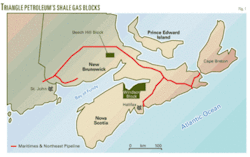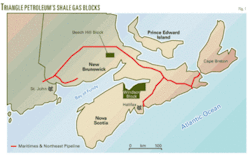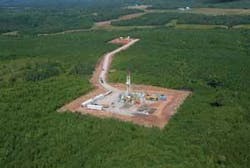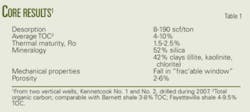Calgary’s Triangle Petroleum Corp. is using expertise honed in Texas’ Barnett shale and Arkansas’ Fayetteville shale to develop shale gas resources in eastern Canada’s Maritimes basin.
The company, through its US subsidiary Triangle USA Petroleum Corp., held a 27% working interest in 12,100 gross acres in northeast Hill County, Tex., developing the Barnett shale in the Fort Worth basin, before divesting that interest in July 2007.
Triangle also explored and drilled 20,000 gross acres in a Fayetteville shale joint venture in the Arkoma basin with Houston-based Kerogen Resources Inc. (OGJ, Sept. 17, 2007, p. 59). The company may divest the Arkansas holdings, said Howard Anderson, Triangle’s president and chief operating officer.
Triangle’s threefold Canadian strategy has been to:
- Acquire an early position in large, contiguous blocks.
- Use expertise gained from previous projects.
- Add joint-venture partners to mitigate risk and accelerate drilling programs.
Windsor Block
Through its Canadian unit, Elmworth Energy, Triangle Petroleum is drilling for shale gas in Nova Scotia’s Windsor Block, 25 miles from the Halifax lateral of the Maritimes & Northeast pipeline (M≠ Fig. 1).
In June 2007, Triangle farmed into 516,000 gross acres (806 sq miles) that Calgary-based Contact Exploration Inc. had acquired from Devon Canada Corp. Triangle took on an $800,000 (Can.) work commitment from Devon-Northstar Energy’s 1999 exploration agreement.1
Contact Exploration and its joint-venture partners recognized two main play types and divided the block into an eastern block with shallow potential in the Devonian-Mississippian Horton Bluff shales and a western block with Windsor Reef potential below salt. Contact, Oiltec Resources Ltd., and Husky Energy explored and drilled several wells targeting Windsor Reef prospects.
Triangle was interested in shale gas; results from the Noel No. 1 well, drilled in 1975, with gas shows in the Cheverie and Horton Bluff formations of the Horton Group, at 350-1,000 m depth. There was no production, but well logs indicated good permeability and porosity.
In 2007, Triangle acquired 30 miles (48 km) of new 2D seismic and 25 sq miles of 3D seismic data over the block, and drilled, cored, and completed two vertical wells in the Kennetcook area of Hants County, about 70 km north of Halifax (Fig. 1).
Precision Rig 176 spud the Kennetcook No. 1 well in August 2007 and drilled to 4,390 ft TD before the rig was released on Sept. 15, 2007 (Fig. 2). Triangle took cores over a 1,150-ft interval of the Horton Bluff shale and sent them to the US for analysis of total organic content, mineralogy, porosity, gas content, and mechanical rock properties (Table 1).
Based on preliminary log analysis, Triangle identified a 350-ft thick primary zone of interest and a 260-ft thick secondary zone.2
Triangle is using slick-water hydraulic fracturing to stimulate the shales and pumped a two-stage frac. The first stage used 850,000 gal of water and 560,000 lb of sand and the second stage used 660,000 gal of water with 386,000 lb of sand at 82 bbl/min, the company reported on Dec. 3, 2007.
The Kennetcook No. 2 well is a few miles northwest of the first well and was also drilled with Precision Rig 176. After reaching a TD of 6,350 ft, Triangle took cores over a 430-ft interval and released the rig Oct. 13, 2007. The Kennetcook No. 2 well was also fraced in two stages, with 1.3 million gal of water and 540,000 lb/sand at 70-80 bbl/min.
At KC2, Triangle began to produce gas with recovered frac water, up to about 60 mcf/day.
Anderson told OGJ that the company’s two wells in 2007 served as a proof of concept, which they further tested this year.
Land tenure
On June 23, 2008, Triangle Petroleum announced that it was partnering with privately held Zodiac Exploration Corp. in the Windsor Block. Calgary-based Zodiac is paying 50% of drilling costs (up to $7.5 million) to earn a 12.5% working interest in the block. Zodiac may use another option to spend $7.5 million to earn an additional 12.5%, which would give it 25% WI and leave Triangle with 45% WI. Contact Exploration retains its 30% interest in the block.
On June 24, Triangle Petroleum, as Elmworth Energy, filed a development plan with Nova Scotia’s Department of Energy as part of its application for a production agreement.
The public comment period ended Sept. 24 and the Ministry of Energy will make a decision on the application by Dec. 22.3
If the application is approved, it will trigger a new 10-year renewable land tenure on the Crown land for Triangle.
2008 wells
Triangle drilled two more vertical wells in the Windsor Block earlier this year with Nabors Rig 4, which has a depth rating of 3,600 m (12,000 ft). These wells are in a new fault block on the north side of the Windsor Block.
The company spud the N-14-A well in July and drilled to 8,500 ft TD. It stepped out 14 miles to the west of N-14-A to spud the second well, O-61-C, in August and reached TD of 9,700 ft (Fig. 3).
The two wells are in different fault blocks.
Anderson told OGJ that the company spud a third well on Oct. 22, to test another new fault block. The E-38-A well was to test Horton Bluff shales as well as conventional targets uphole. Due to hole caving problems, the hole only reached 1,700 m and fell short of the expected 2,200 m TD. The well was cased to 1,500 m, and the rig was released Nov. 14.
Triangle fracture-stimulated the N-14-A well in early December, with four 50-tonne fracs in a 100 m interval at about 1,900 m, Anderson told OGJ.
New Brunswick
Triangle is also looking at gas shales in the Moncton-Sackville subbasin in New Brunswick. In 2007, the company announced that it had executed farm-in agreement for 70% working interest and operatorship in the 68,000-gross-acre Beech Hill Block.
Privately held Forent Energy Ltd., based in Calgary, obtained exploration rights to 466,000 acres in the Alton Block, near Antigonish, NS, from EOG Resources in 2007 and assumed EOG’s work commitment (www.forentenergy.com).
Halifax-based Corridor Resources Inc. is spending $32 million in 2008-09 to assess the Mississippian Frederick Brook shale. Corridor has 118,000 acres under license near Elgin, NB (OGJ, June 16, 2008, p. 39).
Corridor is also developing the McCully project and there is natural gas production from Stoney Creek field, adjacent to Triangle Petroleum’s Beech Hill Block.
Infrastructure
Equipment and services are easier to come by in the Maritime Provinces now that several operators are beginning to form a critical mass, says Anderson. In addition to Triangle and Contact, Stealth Ventures Ltd. is exploring coalbed methane prospects in Nova Scotia, and Calgary’s Forent Energy Ltd. has farmed-in an EOG Resources block.3
Calgary-based Contact Exploration Inc. is the largest acreage holder in Nova Scotia (OGJ, Aug. 21, 2006, p. 46).
Developing resources in the Maritimes is underpinned by the presence of the M&NE pipeline. With success, Triangle thinks it’s possible to tie its expected shale gas production into the pipeline within 2 years.1
Triangle reported its third quarter results for fiscal 2009 on Dec. 11, 2008. The company spent $2.2 million to drill the three Windsor Block wells—N-14-A, O-61-C, and E-38-A—during the quarter.
References
- Triangle Petroleum Corporate Overview, October 2008, www.trianglepetroleum.com.
- Triangle Petroleum, Results for Third-Quarter Fiscal 2008 and Operations Update, Dec. 11, 2007.
- Nova Scotia Department of Energy, http://www.gov.ns.ca/energy/oil-gas/onshore/current-activity/default.asp.






